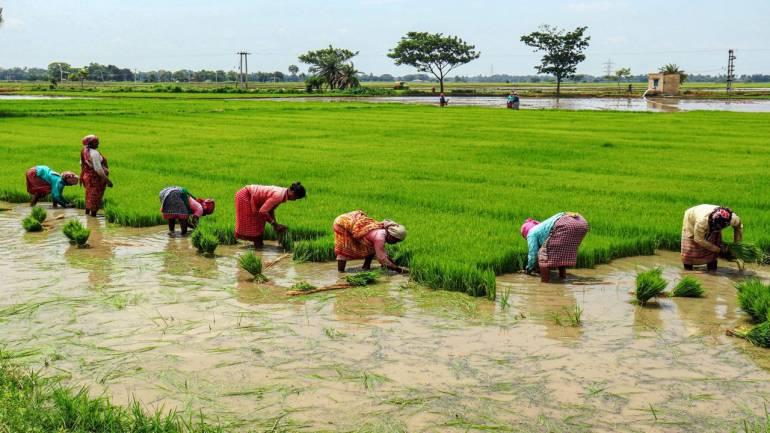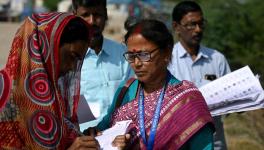Bengal’s Bid to Expand Kisan Credit Card Coverage Coincides with Centre’s Saturation Drive

Kolkata: The West Bengal government has embarked upon a massive expansion of coverage under the Kisan Credit Card (KCC) scheme of the Reserve Bank of India and the National Bank for Agriculture and Rural Development as Kharif sowing activity is set to gather pace and the start of the Monsoon in the state has been satisfactory, according to the Mausam Bhavan’s assessment.
Interestingly, two points emerged as NewsClick sought reaction to this initiative of ‘Nabanna’ – the state secretariat – from informed quarters, some of whom deal with farmers’ issues in the rural areas. First, the state Agriculture Department’s move following the “inspiration” from chief minister Mamata Banerjee has begun at a time when New Delhi’s campaign for saturation of all Pradhan Mantri Kisan Samman Nidhi (PM-Kisan) beneficiaries with Kisan Credit Cards is being vigorously followed by all involved agencies. PM-Kisan completed its first year on February 24 this year.
But, West Bengal is an exception because Banerjee had decided soon after the PM-Kisan was announced on February 1, 2019, not to participate in the scheme. West Bengal is the only state that continues to remain out of the purview of PM-Kisan. Thus, while the Centre is trying hard to see that all PM-Kisan beneficiaries automatically become KCC holders on completion of formalities, West Bengal is sticking to KCC coverage expansion on a stand-alone basis.
The second point that emerged is that farmers’ organisations, which are usually arms of political parties, are not inclined to view the ‘Nabanna’ initiative in the context of the next Assembly elections due in 10 months; although recalling their past experience, they prescribe some “dos and don’ts”.
In the state, there are currently 15 lakh KCC holders and the government wants to take it to 35 lakh, that is, an increase of 20 lakh. The number of farmers in the state is estimated at 70 lakh plus. So, at 35 lakh, the coverage will be 50%. But more than the big farmers, the marginal, small and medium level farmers have been badly hit by Covid-19 and in the midst of the pandemic, by Amphan. Therefore, in the assessment of knowledgeable quarters, the government will try to cover as many as possible under this category and it may keep the estimated 15 lakh big farmers out of coverage, for the moment. Therefore, out of 55 lakh plus farmers, if the target of an additional 20 lakh is achieved and there are 35 lakh KCC holders, total coverage moves up to close to 65%.
An on-the-spot assessment of the damage wrought by Amphan has been made by Agricultural Advisor to chief minister Pradip Mazumdar who, in written replies to points raised by NewsClick, had this to say: “The scale of finance/acre depends on crop and location. The loan amount/kisan depends on area x @ of scale of finance for the crop cultivated. This is a scheme guided by RBI; hence all commercial banks present in rural areas, grameen banks and cooperative banks are involved.”
Regarding eligibility, a former chief manager of erstwhile Dena Bank, Dr N N Goswami, who dealt with agriculture credit for a long time, said the scheme is liberal and all farmers who possess some land for cultivation are eligible. He also said that they include all farmers, owner cultivators, farmers who are not owner cultivator but do cultivation as tenant farmers, “oral lessees” and share-croppers and self-help groups or joint liability groups of farmers including tenant farmers, share-croppers, “oral lessees”, etc.
Farmers could not access institutional finance in times of need for a host of reasons and the situation forced them to depend on “non-institutional, quite costly funds” when their need was acute. The KCC scheme was launched and refined several times to remove farmers’ hardships, entitle them to cheap, timely funds from banking systems. Agriculturists can purchase items related to their farming needs using their KCC and can also withdraw the required amount for related expenses, the former bank executive explained.
The rate of interest is 9%. There is an interest subvention of 2%. Therefore, for the farmer, it is 7%. There is a prompt repayment incentive of 3% for short-term crop loans of up to Rs three lakh. Therefore, those who qualify for PRI have to bear an interest of 4% only.
According to informed quarters, while there is no doubt that KCC has made things better for farmers in general, but “the less fortunate ones” among them still have to count on money lenders and bear with the exorbitant rates of interest. Failure to repay invariably exposes the borrowers to the risk of having to pay in kind and part with a sizable quantity of their produce.
The West Bengal initiative, when through, will certainly help enhance liquidity in the agricultural economy. The timing of launching the initiative is also significant. The Union Agriculture Ministry’s circular of February 6 to, among others, all state governments mentioned the following points:
All charges for processing, documentation, inspection, ledger folio and service for KCC loans up to Rs three lakh waived by Indian Banks Association;
Banks have been instructed to issue KCC within 14 days of receipt of completed application form from farmers...
On the date of issue of the circular, more than 9.7 crore farmer families had been registered on the PM-Kisan portal and the benefit of income support had been transferred to nearly 8.4 crore farmers. There are at present 6.67 crore active KCC in the country. Even if it is presumed that all the active KCC holders are PM-Kisan beneficiaries, there are nearly three crore beneficiaries who do not have KCC. Hence the need for “mission mode” action.
Also read: Has ‘Normalcy’ Made Kashmir More of an Exception?
Why has CM Mamata Banerjee chosen to shun, so far, PM-Kisan? She has put in place a ‘Krishak Bandhu’ scheme under which a yearly grant of Rs 5,000 per acre to farmers is admissible in two instalments for both rabi and kharif crops. In case of shared cropping, the amount is divided proportionally among the share-croppers. Also, the scheme ensures a one-time grant of Rs two lakh for the family of a farmer between the age of 18 and 60 who dies due to “any natural or unnatural cause”.
Under PM-Kisan, an eligible farmer is entitled to get up to Rs 6,000 per year in three equal instalments. The unstated contention of the West Bengal government is that CM has devised a more generous package to help farmers. The fact that by not joining the scheme the state is losing Rs 4,200 crore (Rs 6,000 x 70 lakh farmers) of Central funds is an unacknowledged fact.
The Centre continues to sulk over West Bengal’s non-participation. Agriculture minister Narendra Singh Tomar’s request letters to CM did not elicit any response. Prime Minister Narendra Modi, while speaking at the 150th anniversary celebrations of the Kolkata Port Trust in the city, on January 12 referred to West Bengal’s non-participation (the second instance is Ayushman Bharat) and said he wants policy-makers in West Bengal to be blessed with “good wisdom”.
Interestingly, although the state keeps off PM-Kisan, several lakh farmers had registered themselves since September 2019 via the self-registration portal, indicating their willingness to be part of PM-Kisan. But, the Centre is helpless because the applicants’ data have to be vetted by the state administration.
Meanwhile, farmers’ organisations are of the view that KCC is a good scheme and they are not inclined to view the state government’s move as one being made with an eye on the next Assembly elections. But, there are practical issues. “We have to see whether marginal farmers will benefit. In the Sundarbans area, 90% are those having 10 bighas of land. They have to work for a maximum of three months. Will these people benefit?” asked Sanjukta Kisan Sabha Chief Subhas Naskar, who was minister for irrigation and waterways in the Left Front government.
Naskar, a senior member of Revolutionary Socialist Party’s state committee, pointed out that the Left Front has never impeded the implementation of this government’s good schemes. “But, we cannot forget TMC had opposed the Rs 5,032 crore embankment construction scheme the Centre had okayed after Ayla had caused extensive damage in the Sundarbans in 2009”.
General secretary of West Bengal Pradeshik Krishak Sabha (B B Ganguly Street) Ajit Mukherjee said funds available under the KCC scheme fall short of farmers’ actual requirements. The assumptions made for determining entitlement should be given a re-look. Also, it’s a tough job for share-croppers to get their status vetted by the Agriculture Department, pointed out Mukherjee, whose outfit is an arm of the Communist Party of India.
Chairman of Paschim Banga Krishak Congress Tapan Das said the original farmer often is deprived of the concessional finance under the KCC scheme. Also, too many complications arise as updated documents, showing names of successors, cannot be furnished by applicant-farmers, added Das whose organisation is an arm of West Bengal Pradesh Congress Committee.
Also read: Delhi High Court Seeks MoEFCC Response on Ambiguity in its Notification on EIA
Get the latest reports & analysis with people's perspective on Protests, movements & deep analytical videos, discussions of the current affairs in your Telegram app. Subscribe to NewsClick's Telegram channel & get Real-Time updates on stories, as they get published on our website.






















